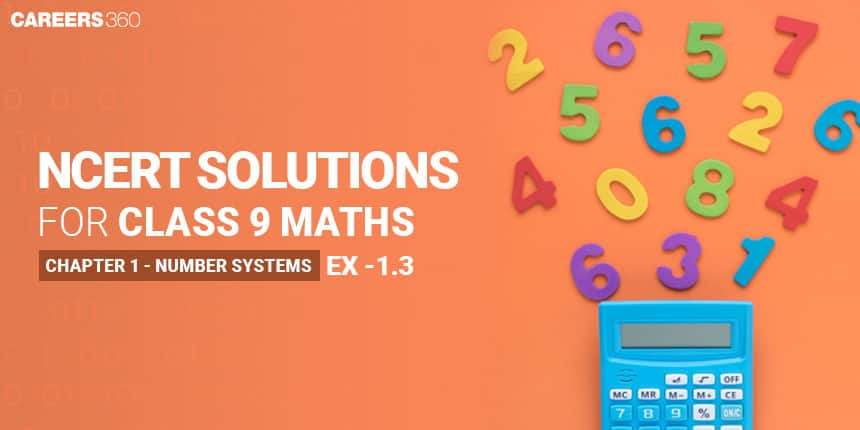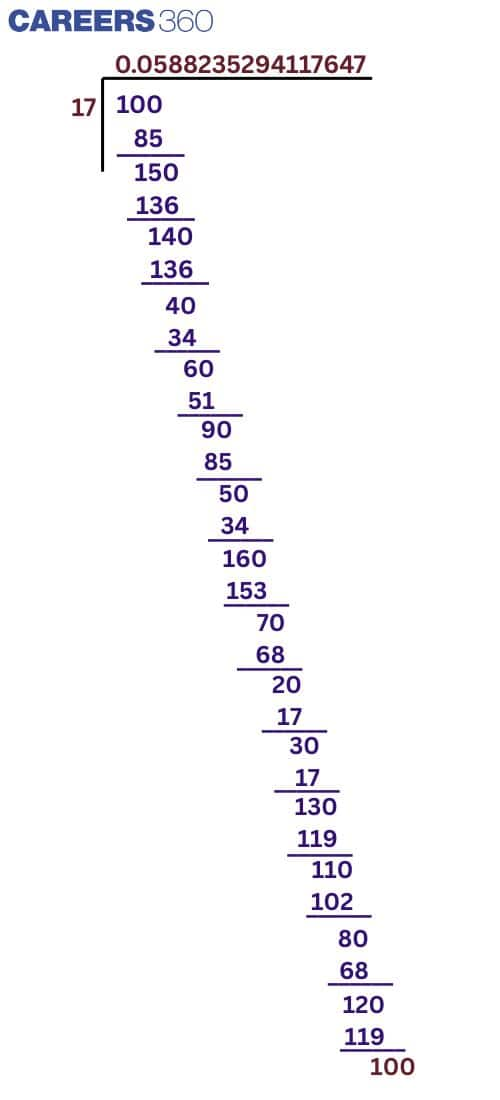NCERT Solutions for Class 9 Maths Chapter 1 Exercise 1.3 - Number Systems
Real number decimal expansions serve as essential knowledge for understanding differences between rational and irrational quantities. Decimals revealing the expression of $\frac{1}{3}$ or $\sqrt{2}$ help us determine its termination pattern as either repeating or non-terminating. This understanding helps people classify numbers appropriately while understanding their characteristics on the number line. The foundational concepts enable to progress into more complex real number-based mathematical fields.
This Story also Contains
- NCERT Solutions for Class 9 Maths Chapter 1 – Number Systems Exercise 1.3
- Access Solution of Number Systems Class 9 Chapter 1 Exercise: 1.3
- Topics covered in Chapter 1 Number System: Exercise 1.3
- NCERT Solutions of Class 9 Subject Wise
- NCERT Exemplar Solutions of Class 9 Subject Wise

In order to understand number classifications better students should consult NCERT Solutions alongside using NCERT Books that include multiple practice problems and detailed explanations. The described resources enable students to recognize decimal expansion patterns while developing better skills in accurate number classification. These educational resources develop essential knowledge which students need when moving toward advanced mathematics concepts.
Access Solution of Number Systems Class 9 Chapter 1 Exercise: 1.3
Answer:
$\frac{36}{100} $ = 0.36
Since the decimal expansion ends after a finite number of steps. Hence, it is terminating
Answer:
$\frac{1}{11} = 0.\overline{09}$
Since decimal expansion repeats itself so it is a non-terminating recurring decimal expansion.
Answer:
$\Rightarrow 4\frac{1}{8} = \frac{33}{8}= 4.125$
Since the decimal expansion ends after a finite number. Therefore, it is terminating
Answer:
$\Rightarrow \frac{3}{13} = 0.230769230769 = 0.\overline{230769}$
Since decimal expansion repeats itself so it is a non-terminating recurring decimal expansion.
Answer:
$\Rightarrow \frac{2}{11} = 0.181818......= 0.\overline{18}$
Since decimal expansion repeats itself so it is a non-terminating recurring decimal expansion.
Answer:
$\Rightarrow \frac{329}{400}= 0.8225$
Since decimal expansion ends after finite number of figures. Hence, it is terminating.
Answer:
Yes, the decimal expansion of 1/7 is:
$\frac{1}{7} = 0.\overline{142857}$
So for other multiples:
$\frac{2}{7} = 0.\overline{285714}$
$\frac{3}{7} = 0.\overline{428571}$
$\frac{4}{7} = 0.\overline{571428}$
$\frac{5}{7} = 0.\overline{714285}$
$\frac{6}{7} = 0.\overline{857142}$
All are cyclic permutations of the repeating part 142857.
Answer:
Let x = $0.\overline{6}$
Then 10x = $6.\overline{6}$
Subtract:
10x - x = $6.\overline{6}$ - $0.\overline{6}$ $\Rightarrow 9x = 6 \Rightarrow x = \frac{2}{3}$
Hemce, $\frac{2}{3}$
Answer:
Let x = $0.4\overline{7}$
Then 100x = $47.\overline{7}$
Subtract:
Let x = 0.477777...
Or x = 0.47 + 0.00777...
Now:
- 0.47 = 47/100
- 0.00777... = y
Let y = 0.00777... = $0.00\overline{7}$
Now write y as:
Y = $\frac{7}{900}$
So:
$x = \frac{47}{100} + \frac{7}{900} = \frac{(423 + 7)}{900} = \frac{430}{900} = \boxed{\frac{43}{90}}$
Hence, $\frac{43}{90}$
Answer:
Let $x = 0.\overline{001}= 0.001001....$
Then $1000x = 1.001001...$
We can write as:
$\Rightarrow 1000x = 1 + x $
After Subtraction:
$\Rightarrow 999x = 1$
$\Rightarrow x = \frac{1}{999}$
Therefore, $\frac{p}{q}$ form of $0.\overline{001}$ is $\frac{1}{999}$
Q4 Express 0.99999 .... in the form $\frac{p}{q}$ . Are you surprised by your answer?
Answer:
Let x = $0.\overline{9}$
⇒ 10x = $9.\overline{9}$
⇒ 10x - x = 9
⇒ 9x = 9 ⇒ x = 1
So, 0.9999… = 1
Yes, it’s surprising but mathematically correct. The difference between 1 and 0.999… is infinitely small — effectively zero.
Answer:
Performing the division:

1 ÷ 17 = 0.0588235294117647… → Repeats after 16 digits
So, maximum repeating block length = 16
Answer:
We can observe that when q is 2, 4, 5, 8, 10… then the decimal expansion is terminating. For example:
$\frac{3}{2}$ = 1.5, denominator q = 21
$\frac{8}{5}$ = 1.6, denominator q = 51
$\frac{15}{10}$ = 1.5, denominator q = 10 = 2 х 5 = 21, 51
Therefore,
It is evident that when the denominator of the given fractions is prime factorized to a power of either 2 or 5, or both, the terminating decimal can be attained.
Q7 Write three numbers whose decimal expansions are non-terminating non-recurring.
Answer:
Three numbers whose decimal expansions are non-terminating non-recurring are
1) 0.02002000200002......
2) 0.15115111511115.......
3) 0.27227222722227.......
Answer:
$\Rightarrow \frac{5}{7} = 0.714285714285.... = 0.\overline{714285}$
And $\frac{9}{11}$:
$\Rightarrow \frac{9}{11} = 0.818181.... = 0.\overline{81}$
Therefore, three different irrational numbers between the rational numbers $\frac{5}{7}$ and $\frac{9}{11}$ are
1) 0.72737475....
2) 0.750760770780...
3) 0.790780770760....
Q9 (i) Classify the following numbers as rational or irrational : $\sqrt{23}$
Answer:
Writing $\sqrt{23}$ in decimal form, we get:
$\Rightarrow \sqrt{23} = 4.7958152....$
Since, the decimal expansion of the number obtained is non-terminating and non-recurring. It is an irrational number.
Q9 (ii) Classify the following numbers as rational or irrational : $\sqrt{225}$
Answer:
Writing $\sqrt{225}$ in decimal form, we get:
$\Rightarrow \sqrt{225} = 15$
It is clear that it is a rational number because we can represent it in $\frac{p}{q}$ form.
Q9 (iii) Classify the following numbers as rational or irrational : 0.3796
Answer:
Writing 0.3796 in fraction form, we get:
$\Rightarrow 0.3796 = \frac{3796}{10000}$
It is clear that it is a rational number as the decimal expansion of this number is terminating and we can also write it in $\frac{p}{q}$ form.
Q9 (iv) Classify the following numbers as rational or irrational : 7.478478....
Answer:
We can rewrite 7.478478.... as
$\Rightarrow 7.478478.... = 7.\overline{478}$
Now, as the decimal expansion of this number is non-terminating recurring. Therefore, it is a rational number.
Q9 (v) Classify the following numbers as rational or irrational : 1.101001000100001...
Answer:
In the case of number 1.101001000100001...
It can be observed that the decimal expansion of this number is non-terminating and non-repeating. Therefore, it is an irrational number.
Also Read:
Topics covered in Chapter 1 Number System: Exercise 1.3
- Understanding decimal expansion of real numbers: The representation of all real numbers occurs through decimals. The decimal representation aids understanding whether a number is rational or irrational through its decimal pattern.
- Identifying terminating and non-terminating decimals: Terminating decimals end after a certain number of digits (e.g., 0.75), while non-terminating decimals go on forever (e.g., 0.333… or 1.4142…).
- Recognizing repeating (recurring) decimals: The decimal value contains one or more repeating numbers which continuously appear following the decimal point like 0.666… or 1.272727…
- Differentiating between rational and irrational numbers based on decimal expansion: A decimal represents a rational number whenever it either ends or displays continuous repetition. An irrational number exists when a decimal number extends endlessly without any pattern of repetition.
- Application: Applying knowledge of decimals to verify the nature of numbers
Check Out-
NCERT Solutions of Class 9 Subject Wise
Students must check the NCERT solutions for class 9 of Mathematics and Science Subjects.
NCERT Exemplar Solutions of Class 9 Subject Wise
Students must check the NCERT Exemplar solutions for class 9 of Mathematics and Science Subjects.
Frequently Asked Questions (FAQs)
Irrational numbers are numbers that cannot be stated in the form of a fraction with an integer in both the numerator and the denominator.
root(49)=7 which can be written as 7/1
Thus 49 is a rational number.
Yes 0 is a rational number (since 0 can be written as 0/1 , 0/2 etc… )
Decimal numbers are classified into
Recurring Decimal Numbers (repeating or Non-Terminating Decimals)
Non-Recurring Decimal Numbers (non Repeating or Terminating Decimals).
The expanded form of 64.3 is 60+4+3/10.
Yes, 0.033 is a non-recurring decimal number. Since 0.033 is a non Repeating and Terminating number.
The dot which is present in between the whole number and fractions part is known as the decimal point.
Courses After 12th
Applications for Admissions are open.
As per latest syllabus. Physics formulas, equations, & laws of class 11 & 12th chapters
JEE Main Important Chemistry formulas
Get nowAs per latest syllabus. Chemistry formulas, equations, & laws of class 11 & 12th chapters
JEE Main high scoring chapters and topics
Get nowAs per latest 2024 syllabus. Study 40% syllabus and score upto 100% marks in JEE
JEE Main Important Mathematics Formulas
Get nowAs per latest syllabus. Maths formulas, equations, & theorems of class 11 & 12th chapters
